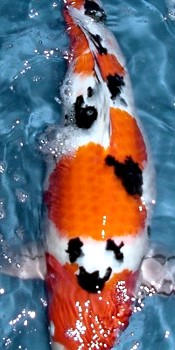It is amazing to see how much Koi (a carp in Japanese) have changed from their original appearances 1000- 2000 years ago in the Far East. These hardy fish were originally bred to be consumed. In Japan, the farmers would look after these fish in their rice fields. A mutation occurred to change the dull brown to a more colorful fish around 1840-1844. The farmers did not eat these prized fish. Instead, they started to breed them and were among the first to see new varieties of Koi develop. There are many Koi varieties today with differences in color, pattern, and scales. One of the more popular varieties is the Sanke (also known as a Taisho Sanshoku). This tri colored Koi (white body with red and black markings) was first seen in 1868-1912. In 1915, a 15 year old Sanke variety Koi was displayed for the first time. In 1927 another variation was displayed and called the Showa Sanke. This variation has a black body with red and white markings. The popularity of raising Koi continued to grow and Europeans started to become interested in the early 20th century with North Americans following soon after.
The Koi fish hobby can be as addictive as a video game for a teenager. They are a fish of beauty and diverse colors. These spectacular fish can show their personality at meal time. Koi are often overly excited when you feed them and sometimes will display jumping and be trained to eat from your hand. They are omnivorous fish, eating both plants and animals (mostly small crustaceans.) Similar to most nutrition plans, Koi will do best with a properly balanced diet.
When properly cared for in an ideal environment, the Koi will possibly outlive their owners. An average Koi lives 23-30 years, but the oldest known Koi fish lived for 226 years. They range in sizes of 2-3 feet and can weigh up to 35-40 lbs. They are a hardy, cold water fish and will flourish in a temperature range of 59-77 degrees F (15-25 degrees C).
When selecting a Koi fish to raise and possibly show, it is best to consider many factors such as the color, pattern, body, and overall health. Look for a healthy fish without any body deformities or missing fins. The color should be even and pure with a balanced pattern. When judging the body of a Koi, the head should be symmetrical and in proportion to the body. An easy way to gauge correct proportion is by looking for a smooth transition of the gill plate that divides the head and body. The best Koi shape is larger at the middle with a gradual tapering towards the head and even more so at the tail. Take into consideration the size of the snout and fins.
For the Sanke variety, the white (shiro) body should be a thick, milky white and not have any yellow tinting or blemishes. The red (hi) markings should be solid and evenly colored and the edges (kiwa) should be defined. The hue can range from a bright orange to a deep red tint. The black (sumi) markings should be solid with clearly defined edges as well. The spotting of dark blue or gray can change into black on a young Koi as it matures. Try to avoid Sanke with any black on the head.
A (red) hi pattern that moves from the head to tail continuously is known as an Aka Sanke and are less desired. A Tancho Sanke has a red round patch on the head, with no other red on the body. This Sanke variation is highly sought after in Japan because of the similarity in appearance to the Japanese national bird. If there are red markings on the body as well, then it is known as a Maruten Sanke.
The best way to determine what the high quality Koi looks like is to become familiar by looking at photos of Koi, by joining a Koi club and attending Koi shows. With time, research, and experience, any hobbyist will be able to select the best Koi for their pond and enjoy them for many years.

The Sanke look like Kohaku, but they have a black stepping stone pattern that runs along their back. The black pattern is called Sumi. A good looking Sanke will have a good Kohaku Hi pattern. The black pattern must not show up on the head and it should not be touching the Hi. Sanke are bred by crossing a Kohaku with a Shiro Bekko.
The best sumi patterns on Sanke look like the dabs of an artist's brush!
Many people have a hard time telling the the difference between a Showa
and a Sanke. "How do you tell the difference?" they ask. Here are a couple of pointers: 1. Sanke do not have black on their heads, the Showa do. 2. Sanke are white Koi, with red and black patterns. Showa
are black Koi, with a white and red pattern.
Sanke Gallery
Back to the Koi Types.